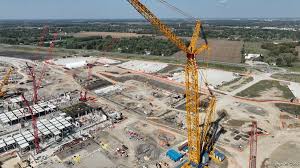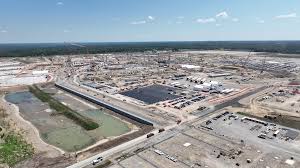
NEW ALBANY, Ohio (WCMH) — Intel’s surprise announcement that it is “slowing construction” on its massive semiconductor complex in New Albany has raised questions about what that really means for Ohio’s economy and the thousands of jobs tied to the project.

The statement left many wondering if “slowing” is simply a pause — or a warning sign of deeper problems that could threaten the multi-billion-dollar facility touted as one of the biggest economic development wins in Ohio’s history.
So far, both Intel and Ohio leaders insist it’s exactly what it sounds like: a deceleration, not a halt.
Intel told Columbus Business First that the decision does not change its ultimate timeline — the 2031 target for full completion remains unchanged for now — and that they are adjusting the pace in response to market conditions and demand for chips.
“You have to look at things that are frankly beyond our control in Ohio and that is the state of the industry and how well Intel is doing in selling their product,” said Gov. Mike DeWine, who held a press conference after speaking directly with Intel’s new CEO about the situation.
“The conversation I had with him was frankly optimistic. He described the situation of the company as it has been reported by a whole bunch of people, but he was optimistic about the future and frankly the future of the Ohio site,” DeWine added.
The project — often dubbed the “Silicon Heartland” — was originally pitched as a $20 billion investment that would create 7,000 construction jobs and at least 3,000 high-paying tech jobs once the chip fabs are operational.
Carrie Ghose, senior reporter at Columbus Business First, says much of the early work is already well underway. “There’s supposed to be 7,000 construction jobs at that site before they even create 3,000 jobs for inside the fabs,” Ghose explained. “They completed a lot of construction already. They started building the office portion vertical and you could see in January that there’s a first level of the fabs going up. So it’s not something that they can really walk away from.”

Still, uncertainty lingers after Intel laid off 15% of its workforce this year amid falling earnings and tough competition in the semiconductor market. Ghose says the local impact on Ohio’s newly hired Intel trainees remains to be seen: “We do know that Intel had started hiring for Ohio, training those people in Arizona and Oregon. We don’t know what’s going to happen to those people. Are they caught up in this latest round of layoffs that was announced?”
Business leaders in Ohio say they remain confident the project will deliver the economic promise that sparked bipartisan support and hefty state and federal incentives.
Steve Stivers, president of the Ohio Chamber of Commerce, said in a statement: “Despite changes to the timeline, we remain confident in the long-term vision and impact of this transformational project. Intel’s investment in Ohio represents a generational opportunity to strengthen our state’s economy, workforce and global competitiveness.”
Kenny McDonald, president and CEO of Columbus One, echoed that sentiment: “Timelines in complex manufacturing can shift, but the strategic necessity doesn’t. Our state and local partners signed on for the long haul because bringing next-generation semiconductors home is mission-critical for U.S. competitiveness and security.”
Sen. Jon Husted, who has been closely involved with the project, said in a statement to NBC4: “They reiterated to me that they are committed to Ohio. For our economic and national security, the fundamental premise hasn’t changed: We need to make chips in America.”
As market dynamics continue to shift, DeWine says he plans to meet with Intel’s new CEO in person later this year to keep Ohio’s landmark tech investment on track — and make sure the slowdown doesn’t become something more permanent.
For now, Ohio leaders say the state is still all in on what’s been called the largest single private-sector investment in Ohio history — betting that high-tech chipmaking will help define the region’s economic future for decades to come.
Originally reported by Anna Hoffman in NBC 4.